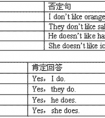Correct. 改错。( ) 1.We like same colour. A B C D( ) 2. Ilikeskirt.AndIdon't likedress.A B C D( ) 3.This are purple grapes.A B C D( ) 4.What are your f-四年级英语
第三人称单数形式,用is
第一人称复数、第二人称、第三人称的复数形式,则用are
一般将来时:
will be
一般时态有关be动词的口诀:
我用am,你用are,is连接他/她/它,复数形式就用are
be动词的用法:
现在时 I am, you are, he is, we are, you are, they are
(缩略式 I'm, you're, he's, we're, you're, they're),
(否定缩略式 I'm not, isn't, aren't),
过去时 I was, you were, he was, we were, you were, they were
(过去时否定缩略式 wasn't, weren't),
过去分词been,现在分词being
英语的“be”是个特殊动词;有些语言,如马来文等,并没有“be”这样的动词。
“Be”除了原形的“be”之外,还有另外七种形式:
am, is, are, been, being, was, were.
在句子中,“be”可以是主动词(The Principal Verb)或助动词(The Auxiliary Verb)
一、口诀:
我用am,你用are,is连着他,她,它;
单数名词用is,复数名词全用are;
变疑问,往前提,句末问号某丢弃;
变否定,更容易,be后莫忘记;
疑问否定任你变,句首大写莫迟疑。
二、Be动词在一般过去时中的变化:
1、am和is在一般过去时中变为was;
2、are在一般过去时中变为were
3、带有was或were的句子,其否定、疑问的变化和am is are一样,即否定句在was或were后加 not,一般疑问句把was或were调到句首。
考点名称:连词
- 连词:
是连接单词、短语或句子的一种词,连词不能独立担任句子成份,而只起连接作用。
连词可分为两大类:并列连词和从属连词。 - 连词的用法:
一、并列连词:
1.and连接单词MybrotherandIstudyinthesameschool。
连接短语Ourknowledgemaycomefromthebooksandfrompractice。
连接句子Wearesingingandtheyaredancing。
2but但是/而是Ihaveapenbutnopencil.or或者Willyougotherebybusoronfoot
3.nothingbut除了,只有Ididnothingbutwatchit。
4.or表示否则Hurryuporyouwillbelate。
5.for表示因为Heisgoodatmathforhestudiesharderthanothers。
二、从属连词:
1.after表示“时间”,在…之后
AfterIfinishedtheschool,Ibecameaworkerinthefactory。
2.although/though表示让步,“尽管”Althoughsheisyoung,sheknowsalot。
3.as表示时间,“当…时”,方式“象…”,原因,“由于、因为”让步,“尽管、虽然”
Asitwaslate,wemustgonow。
4.asif/asthough表方式,“似乎、好像”
Hetoldissuchastoryasthoughhehadbeentherebefore。
5.aslongas/solongas表条件,“只要”AslongasIamfree,I’llgotohelpyou。
6.assoonas表时间,“一…就…”IwillphoneyouassoonasIcomeback。
7.because表原因,“因为”IhavetostayinbedbecauseIamill。
8.before表时间,“在…之前“Youshouldthinkmorebeforeyoudoit。 比较and和or
①并列结构中,or通常用于否定句,and用于肯定句。
②但有时and 也可用于否定句。请注意其不同特点:
There is no air or water in the moon.
There is no air and no water on the moon.
在否定中并列结构用or 连接,但含有两个否定词的句子实际被看作是肯定结构,因此要用and。
比较so和 such
其规律由so与such的不同词性决定。
such 是形容词,修饰名词或名词词组;
so是副词,只能修饰形容词或副词;
so 还可与表示数量的形容词many,few,much, little连用,形成固定搭配。
so + adj. such + a(n) + n.
so + adj. + a(n) + n. such + n. (pl.)
so + adj. + n. (pl.) such +n. (pl.)
so + adj. + n. [不可数] such +n. [不可数]
so foolish such a fool
so nice a flower such a nice flower
so many/ few flowers such nice flowers
so much/little money. such rapid progress
so many people such a lot of people
so many 已成固定搭配,a lot of 虽相当于 many,但 a lot of 为名词性的,只能用such搭配。
so…that与such…that之间的转换既为 so与such之间的转换。- 小学阶段常见的连词:
(1)and(和)表示并列和对称
例:I like basketball and football. 我喜欢篮球和足球。
She likes singing and dancing. 她喜欢唱歌和跳舞。
(2)or(或者,还是)表示选择。(常出现在选择疑问句中)
例:Is it big or small?
(3)if(如果……)表示条件。
例:We will go to the zoo if it does not rain tomorrow. 如果明天不下雨,我们就去动物园。
(4)because(因为……)表示原因。
例:John doesn’t come to school today because he is ill. 约翰今天没来上学,因为他病了。
Li Lei was late for class because he got up late. 李雷上课迟到了,因为他起床迟了。
(5)but(但是)表示转折。
例:The skirt is nice, but it’s too expensive. 这条裙子很漂亮,但是太贵了。
(6)for(因为)表示原因。
例:He must be at home now, for it’s raining. 他现在一定在家,因为正在下雨。
(7)so(因此、所以)表示原因。
例:He got up late, so he missed the train. 他起床晚了,因此错过了火车。
- 最新内容
- 相关内容
- 网友推荐
- 图文推荐
| [家长教育] 孩子为什么会和父母感情疏离? (2019-07-14) |
| [教师分享] 给远方姐姐的一封信 (2018-11-07) |
| [教师分享] 伸缩门 (2018-11-07) |
| [教师分享] 回家乡 (2018-11-07) |
| [教师分享] 是风味也是人间 (2018-11-07) |
| [教师分享] 一句格言的启示 (2018-11-07) |
| [教师分享] 无规矩不成方圆 (2018-11-07) |
| [教师分享] 第十届全国教育名家论坛有感(二) (2018-11-07) |
| [教师分享] 贪玩的小狗 (2018-11-07) |
| [教师分享] 未命名文章 (2018-11-07) |


![Mrs Smith can _____ piano. [ ]A. play the B. playedC. plays the -六年级英语](http://www.00-edu.com/d/file/ks/4/1/19/2019-08-14/small7dd443171fd8fd01bff0ec5b631cd2a41565791318.jpg)

![Look! Thetwo are __________.[ ]A. thedifferent B. different C. thesame-四年级英语](http://www.00-edu.com/d/file/ks/4/1/19/2019-08-14/smalle5a45634611c2390d8031c73d46000df1565791186.gif)
